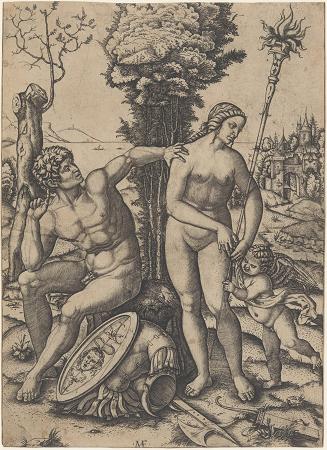Venus / Aphrodite. Venus is a Roman goddess, whose functions encompassed love, beauty, desire, sex, fertility, prosperity and victory. Venus is often depicted nude or semi-nude, symbolizing her association with beauty, desire, and sexuality. This is seen in works such as Botticelli's The Birth of Venus and Titian's Venus of Urbino. Venus is sometimes depicted holding a mirror, symbolizing her vanity and her association with beauty. In Roman mythology, she was the ancestor of the Roman people through her son, Aeneas, who survived the fall of Troy and fled to Italy. Julius Caesar claimed her as his ancestor. Venus was central to many religious festivals, and was revered in Roman religion under numerous cult titles. The Romans adapted the myths and iconography of her Greek counterpart Aphrodite for Roman art and Latin literature. In the later classical tradition of the West, Venus became one of the most widely referenced deities of Greco-Roman mythology as the embodiment of love and sexuality. The Latin name of this goddess derives from the noun venus. Venus has been described as perhaps the most original creation of the Roman pantheon, and an ill-defined and assimilative native goddess, combined with a strange and exotic Aphrodite. Her cults may represent the religiously legitimate charm and seduction of the divine by mortals, in contrast to the formal, contractual relations between most members of Rome's official pantheon and the state, and the unofficial, illicit manipulation of divine forces through magic. In myth, Venus-Aphrodite was born of sea-foam. Roman theology presents Venus as the yielding, watery female principle, essential to the generation and balance of life. Her male counterparts in the Roman pantheon, Vulcan and Mars, are active and fiery. Venus absorbs and tempers the male essence, uniting the opposites of male and female in mutual affection. She is essentially assimilative and benign, and embraces several otherwise quite disparate functions. She can give military victory, sexual success, good fortune and prosperity. In one context, she is a goddess of prostitutes; in another, she turns the hearts of men and women from sexual vice to virtue. Prospective brides offered Venus a gift before the wedding; the nature of the gift, and its timing, are unknown. Some Roman sources say that girls who come of age offer their toys to Venus; it is unclear where the offering is made, and others say this gift is to the Lares. In dice-games, a popular pastime among Romans of all classes, the luckiest, best possible roll was known as Venus. Like other major Roman deities, Venus was given a number of epithets that referred to her different cult aspects, roles, and her functional similarities to other deities. Her original powers seem to have been extended largely by the fondness of the Romans for folk-etymology, and by the prevalence of the religious idea nomen-omen which sanctioned any identifications made in this way. Venus Acidalia, in Virgil's Aeneid. Servius speculates this as reference to a Fountain of Acidalia where the Graces were said to bathe; but he also connects it to the Greek word for arrow, whence love's arrows and love's cares and pangs. Ovid uses acidalia only in the latter sense. It is likely a literary conceit, not a cultic epithet. Venus Caelestis, used from the 2nd century AD for Venus as an aspect of a syncretised supreme goddess. Venus Caelestis is the earliest known Roman recipient of a taurobolium, performed at her shrine in Pozzuoli on 5 October 134. This form of the goddess, and the taurobolium, are associated with the Syrian Goddess, understood as a late equivalent to Astarte, or the Roman Magna Mater, the latter being another supposedly Trojan Mother of the Romans Venus Calva, a legendary form of Venus, attested only by post-Classical Roman writings which offer several traditions to explain this appearance and epithet. In one, it commemorates the virtuous offer by Roman matrons of their own hair to make bowstrings during a siege of Rome.
more...














